4527
Views & Citations3527
Likes & Shares
Background: Bionomics, sensu Ingegnoli, profoundly upgrades traditional ecology's main principles by being conscious that Life on Earth is organized in a hierarchy of interrelated space-time-information levels (complex living systems), that each level cannot exist without its proper environment and that it is possible to define a state of health for each level. This paper aims to demonstrate the capability of bionomic principles to relate it with the incidence of cancer, findings other correlations besides the conventional ones.
Methodology: The main systemic bionomic state functions, biological territorial capacity of vegetation (BTC) and human habitat (HH), may form an impressive diagnostic model of pathological environmental conditions even at the regional scale. Thus, the bionomic state of 16 EU nations (90% of EU population) plus the UK and two essential regions has been evaluated using 2012 and 2020 data. Cancer incidences (Age Standardized Rate, ASR) were evaluated in these countries following the EU Journal of Cancer and ECIS (EU Cancer Information System).
Results: A surprising correlation with cancer emerges, reducing the importance of other conventional parameters: BTC alteration may influence cancer more than Pesticides' presence.
Interpretation: Systemic medicine, firstly PNEI (psycho-neuro-endocrine-immunology), can explain the damages of environmental bionomic alterations to our health. Landscape pathology produces stress, which influences our body defenses, both hormonal and mental, leading to higher morbidity (primarily cancer).
Keywords: Bionomics, Ecology, Medicine, Cancer incidence, BTC, HH
INTRODUCTION
Cancer is a pathology presenting multiple factors and crossing various phases: Bio-molecules, genes, epigenetics, environment, diet and behavior play essential roles in carcinogenesis. These six fields can be reduced to two: the ecological one, strictly linked with environment, diet and behavior; the microbiological linked with cell and gene structure. The recent epigenetics field should be crucial because it can link both, but its real value is challenging to understand because of the asymmetry between ecology’s and microbiology’s supports in cancer research [1].
Indeed, today the environment is generally limited to some pollutants, and often doubtfully, as in the case of glyphosate; diet and behavior have recently increased their importance but remain only marginal, especially in therapy integration. The biological studies on bio-chemical molecules, genetic scales, viruses, metabolism brought to win many challenges but also produced insidious errors, as the DNA “central dogma of molecular biology” [2], because the DNA is not a set of formed characters but a set of potentialities [3]. Moreover, we can note the emergence of peculiar paradoxes: tumor cells have and retain the properties to proliferate abnormally, avoid apoptosis, etc., independently of other genetic factors; this autonomy is well represented by the paradox that emerges in cancer research when accounting for carcinogenesis based on DNA mutations [4], where quite often the same genes are involved in oncogenetic or tumor reversion processes or, even, they seem to follow, more than anticipated, the neoplastic transformation of the cells.
Another tricking error is the marginalization of biological macro-scales (from landscape to eco-region), arriving to refuse a right scientific role to the researchers in this field: in medicine, even today, many physicians think to the fallacy of ecological and environmental aspects in etiology; traditional Biology is still mainly reductionist, focusing only on microscale, from genome to organism. Nevertheless, the “rock in the pond” [5-7] of the systemic turn in scientific paradigms imposes to change our vision: the alterations of Life at wider scales can damage human health, not unlike small ones! As underlined by Bottaccioli [8] health and disease depend primarily on Life's organization, and we must affirm 'on the full organization': so, the study of biology must be upgraded even to the broader scales, trying to understand their anatomical components (structure), physiological processes and functions, transformation processes and pathologies, and to make a clinical-diagnostic evaluation and to formulate a “sanitation” therapy.
The present research started a few years ago, after a question posed to Ingegnoli by Francesco Lombardo, professor of endocrinology at the Sapienza University of Rome, concerning the high level of cancer incidence in nations like Denmark, one of the most civilized nations within Europe and with undoubted attention to fight pollution. This work aims to show the importance of macro-scale biology even in cancer incidence: we will see that other environmental parameters reach a stronger correlation with cancer onset. A new ecological discipline is necessary to reach these goals.
A NEW THEORETICAL DISCIPLINE
From traditional ecology to bionomics
General Ecology asserted that Life organization consists of hierarchic levels: cell, organism, population, communities (i.e., the “biological spectrum” sensu Odum [11]) and life support systems. But we may observe that the world around life (an organism, a community) concerns other life systems; so, the concept of ‘support’ must be changed into that of ‘integration’. That is why the concept of Life cannot be limited to a single organism or a group of species, but it also includes ecocoenotopes, landscapes, ecoregions, and the entire ecosphere (eco-bio-geo-noosphere): as all remember, the Gaia Theory [12] has claimed that the Earth can be considered a living entity.
Delving into what stated by Bionomics (i.e., the Theory of Life Organization on Earth) [1,7], Life on Earth is a complex open process, operating as a hyper-complex system with a continuous exchange of matter, energy, and information with its environment: information is the exchange (interrelation) that allows the emergence of cognitive distinction (order) between players (the components of the system). Consequently, Life on Earth is organized in a hierarchy of six interrelated space-time-information levels (Table 1), and each level cannot exist without its proper environment because of these integration and exchanges.
Following the Systemic Theory, it is evident the difference between what really exists (Real Systems: Life on Earth organized in Living Entities) and the different approaches to the study of the environment (viewpoints), as exposed in Table 1: it’s a complete transformation of the main principles of traditional ecology by being aware that hierarchical levels are types of living complex systems; thus, it is possible to define a state of health for each level.
Some basic concepts to study environmental functionality at territorial and regional scales
In 1999-2001, four Nobel Prizes in Biology (Baltimore, Dulbecco, Jacob, and Levi-Montalcini) edited the book “Frontiers of Life,” published by Treccani (Rome) and Academic Press (Boston): the section on Landscape Ecology [13], already stated that
- Processes allowing life definitions are ontological, but each specific biological level emerges, expressing these processes adequately.
- The relation between pathology and ecology of the systems will allow a diagnosis, in a clinical sense, of them.
- Both the landscape and the system of landscapes (=region[1]) are complex systems, existing as biological entities within a complete Life’s Hierarchy -at respectively district/territorial and province/regional scale-whose character and behavior are more than the result of the action and interaction of natural and human components [14]. Thus,
- The landscape structure is not an ecological mosaic, as stated by conventional ecology, but an Ecotissue: a multidimensional structure, as a histologic tissue, which represents the hierarchical intertwining of the ecological upper and lower biological levels and of all their relationships within the landscape (Figure 1a).
- As living systems, landscapes are self-organizing, adaptive, dynamic, self-regulating, dissipative, metastable[2].
- The key role in ensuring Life and structuring landscapes pertains to vegetation communities, the physiology of which leads to the concept of the ‘latent capacity of homeostasis’ of a phytocoenosis: it needs to dissipate its energy’s excess to maintain its organizational and metastability level, through a flux (Mcal/m2/year) evaluable by a systemic function, the Biological Territorial Capacity of Vegetation (BTC) [14-16].
Pay attention that BTC represents the fundamental state function[3] of a territorial system, proved the indisputable role of vegetation communities (both natural and anthropized, even if with different significance) in managing the energy of the whole system to reach, rebalance and maintain its proper metastable equilibrium. The natural landscape units and sub-units, with the dominance of natural components and biological processes, capable of healthy self-regulation, represent the Natural Habitat (NH) (Figure 1b).
By contrast, the systemic state function named Human Habitat (HH) is able to evaluate how much man can affect and limit the natural systems' self-regulation capability. Following Bionomics, the HH cannot be the entire territorial (geographical) surface (% of Landscape Unit): it concerns the human landscape’s transformed sub-units (e.g., urban, industrial, and rural areas) but also the semi-human ones (e.g., semi-agricultural, plantations, ponds, managed woods), each with its proper weighted average value of human apport of subsidiary energy and technology.
The comparison between two very different agrarian landscapes near Milan in Figure 2 shows the useful applications of HH and BTC's exposed concepts. Note that the BTC level difference is very sharp: Oltre-Po > BTC = 1.75 Mcal/m2/year Vs. Chiaravalle > BTC = 0.73 Mcal/m2/year, while the HH are closer. This example may also demonstrate the capability of bionomic principles to evaluate a complex ecological system's health in a very synthetic view.
The Landscape Functionality, that is processes, functions and roles within landscapes, relating abiotic components, vegetation, fauna and humans, are performed through formal elements organized as Landscape Apparatuses. The main Landscape Apparatuses can be defined as follows (Figure 1b):
- HGL = Hydro-geologic (emerging geotopes or elements dominated by geomorphic processes)
- RNT = Resistant (elements with high metastability, e.g., forests)
- RSL = Resilient (elements with high recovery Capacity, e.g., prairies or shrublands)
- PRT = Protective (elements that protect other components or parts of the mosaic)
- PRD = Productive (elements with high production of biomass)
- SBS = Subsidiary (systems of human energetic and work resources)
- RSD = Residential (systems of human residence and dependent functions)
Let us remember that the study of the Pathology of any biological system, independently from the levels of scale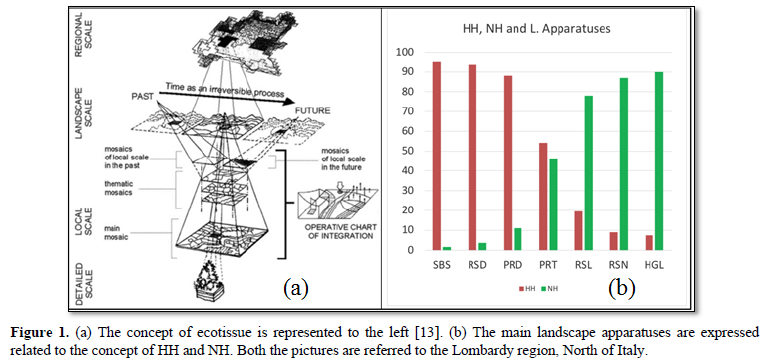
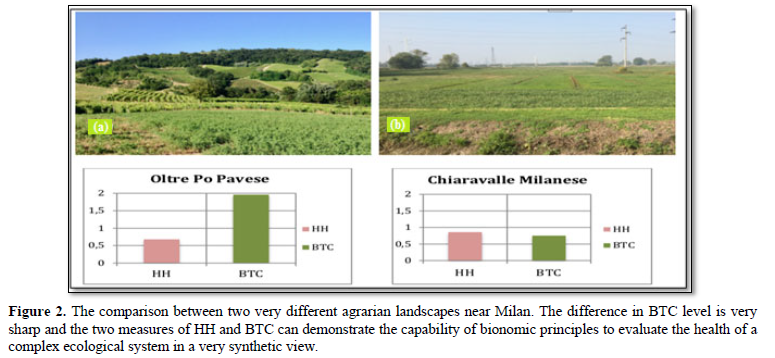
and the organization, needs a basic diagnostic methodology, which cannot be avoided. This is true also for landscape dysfunction, and it may be articulated in six phases:
- Survey of the symptoms.
- Identification of the principal causes.
- Analysis of the reactions to pathogen stimuli.
- Risks of ulterior worsening.
- Choice of therapeutic directions.
- Control of the interventions.
Identifying the leading causes producing landscape syndromes [1,9,14,15] needs a good knowledge of the anatomy and physiology of the complex system of ecocoenotopes, their pathologic disturbances, and a good anamnesis. Semeiotic must be added, in which even perceptive studies may help.
MATERIALS AND METHODOLOGY
As we can see in Figure 3, the BTC [Mcal/m2/year] of vegetation formations differ very much: values for grass and crop-fields range between 0.50 and 1.40, while vines, shrubs, plantations, and gardens from 1.50 to 3.50; adult/mature forest from 6.50 to 9.50 within Temperate Ecoregions as Europe. Ranges of BTC [Mcal/m2/year] values derive from about 450 vegetation surveys in Mediterranean Italy, North Italy, Austria, Belgium and Poland, both on natural and human formations.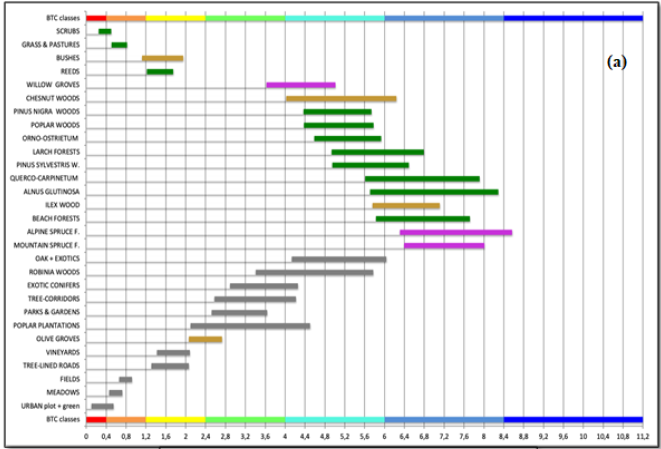
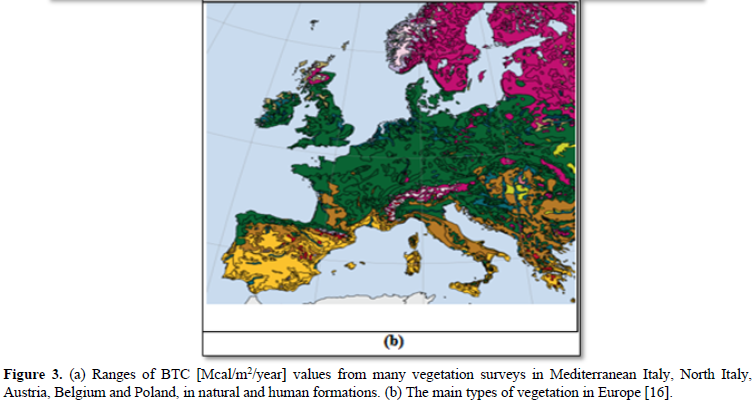
The bionomic state of 16 EU nations (Austria, Belgium, Denmark, Finland, France, Germany, Greece, Hungary, Ireland, Italy, Nederland, Poland, Portugal, Romania, Spain, Sweden), 90% of EU population and 82.5 % of the EU territory, plus the UK and two essential regions, Bayern and Lombardy, has been evaluated using 2012 and 2020 data from EEA 2011-12 and 2017-19 [18,19]. The choices of the countries derived from availability of their environmental data, hard to process because of the different ways of estimation: each of these countries needed elaborations directed to find their average HH (HHw) and BTC (BTCw); particular attention was done to the BTC because of the difference in forest typologies and land cover as resulted by Table 2. Unfortunately, the lack of appropriate data enables us to evaluate the CBSt (Ecological Efficiency of vegetation) [1,9], a more fitting parameter for the evaluation of landscape and regional health.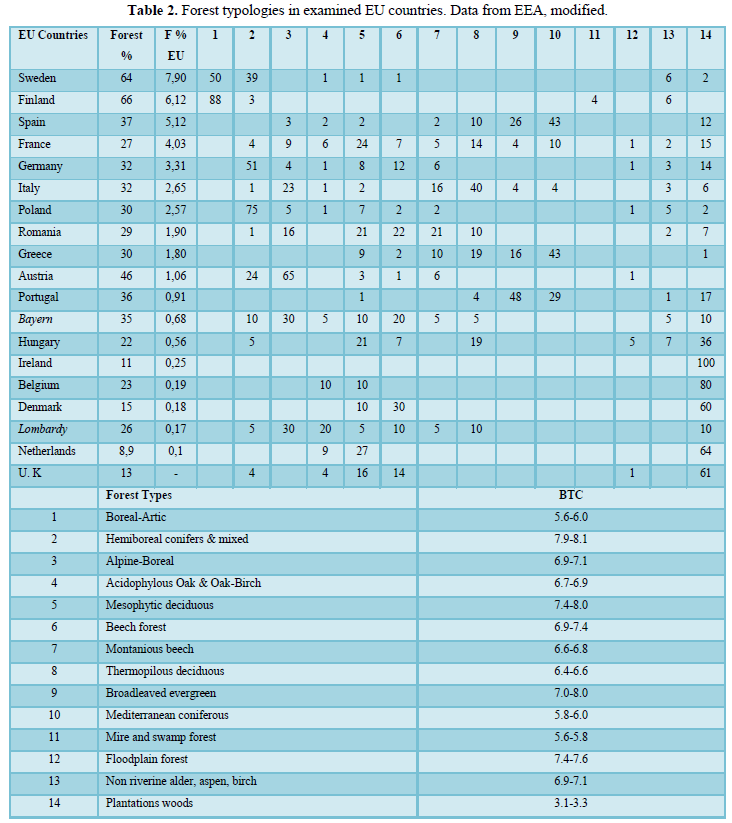
As an example, Table 3 shows France's case study in 2012 and 2020 (data collected from EEA Corine Land Cover and Land Use and FAO and EEA statistics on Forest 2010-2018 [20]). As shown in this table, the landscape elements forming each landscape apparatus have been reported in a synthetic way, but with more details in the resistant apparatus (RNT) because of its importance in BTC weighted mean.
Tables 4 and 5 give an exhaustive frame of all information related to the examined countries: they show the cancer incidence in 2012 and 2020 (Age Standardized Rate, ASR, evaluated following the EU Journal of Cancer and ECIS-EU Cancer Information System [21,22]) and the primary environmental parameters to be correlated to HH and BTC for the 19 mentioned “countries”.
These environmental parameters can be divided into two groups related to the alteration modality of the environment, diet, and behavior: (a) representing excess processes (GDP, HH, Urban population, Glyphosate,
Pesticides, Beef consumption) and (b) expressing the lack of protective conditions (average BTC, Forest, Organic Farming). Note that air pollution (PM10 and 2.5) was not inserted in these rankings because of its impossibility to have a correct and meaningful average at a national scale.
RESULTS
The first result regards the worrying increase of cancer incidence in Europe, as plotted in Figure 4. In this period 2012-2020, the weak bionomic level of the environment was not able to slow the cancer increase, which grown from an average of 326 to 568/100,000. In this altered environment, the mentioned oncological increase reinforced the correlation significance of BTC, the function mainly representing the bionomic state of a country. In 2012 a level of BTC = 3.00 Mcal/m2/year indicated a lower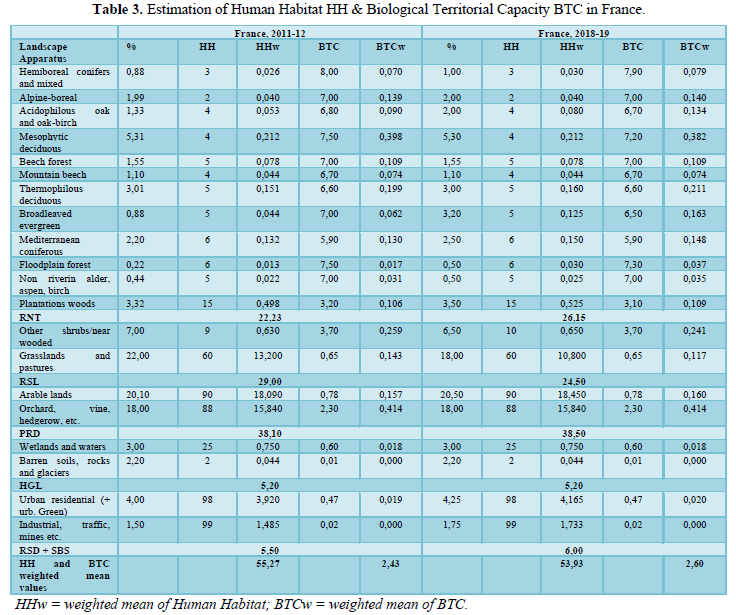
incidence of cancer= 310/100,000 respect to BTC= 0,9 Mcal/m2/year with 380/100,000, while in 2020 the same range of BTC brought the cancer incidence from 550 to 660/100,000: an angular coefficient of 0,334 Vs. 0,524, that represent in 2020 a decline of 52 patients per BTC degree (1.0 Mcal/m2/year) Vs. 33 in 2012.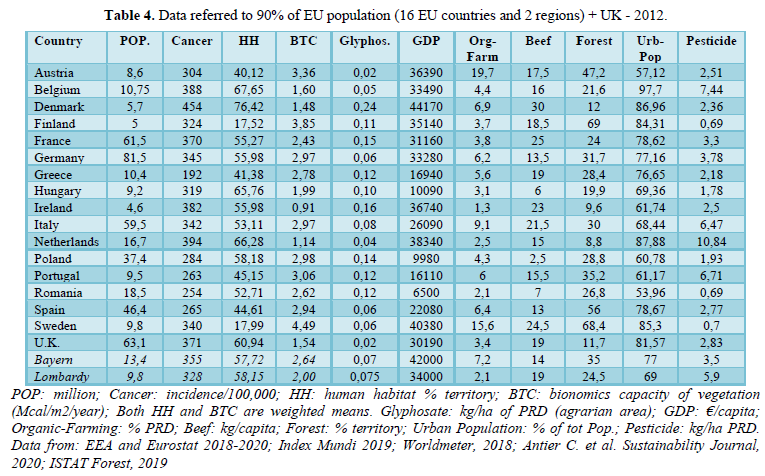
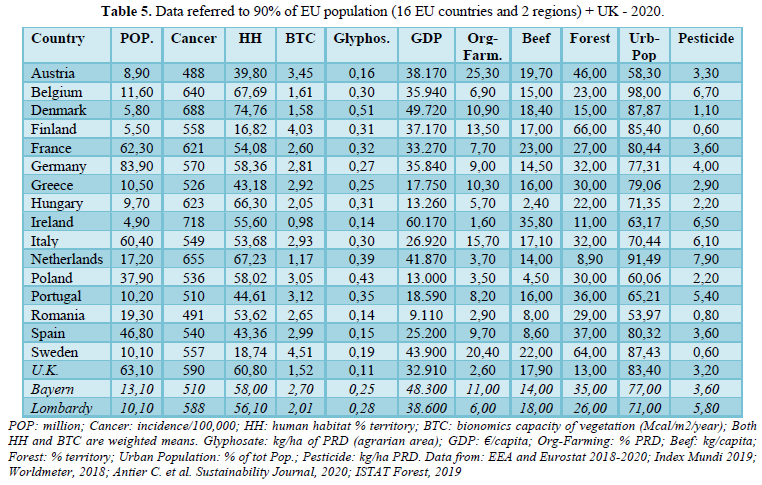
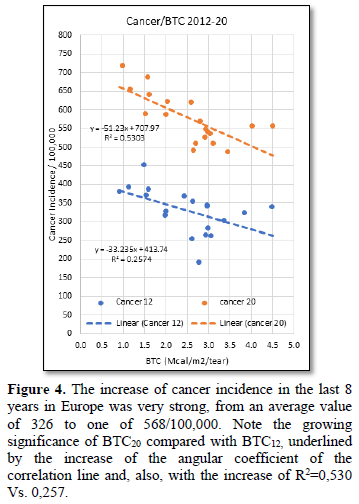
The influence of the bionomic state of the environment on cancer incidence can better emerge from Figure 5, in which the function of BTC is related with the function of HH. Note the strong increase of cancer incidence for HH > 53 %.
This figure shows the situation of the 19 examined countries in 2020, dividing the grade of their bionomic state in five classes, from semi-natural to hyper-anthropized (squares from blue to red). The situation was near the same in 2012, with error of about 2 %. The mentioned classes depend on the levels of BTC and HH along the correlation line (R2=0,71) in the following way:
- BTC = 3.40-4.90 Mcal/m2/year; HH = 15-25 % (Low), Semi-natural countries, (blue Square), only two nations: Finland and Sweden.
- BTC = 2.40-4.00 Mcal/m2/year; HH = 37-47 % (Medium), Semi-Anthropic countries, (green Square), four nations: Austria, Spain, Greece, Portugal.
- BTC = 1.70-3.40 Mcal/m2/year; HH = 48-59 %; Large-populated Anthropic countries, (brown Square), seven countries: France, Germany, Italy, Poland, Romania, Bayern, Lombardy.
- BTC = 0.90-2.50 Mcal/m2/year; HH = 59-69 % (high), High Anthropic countries, (violet Square), four nations: Belgium, Hungary, Nederland, U.K.
- (a) HH = 50-60 %; BTC = 0.10-1.50 Mcal/m2/year; (b) HH = 69-79 %; BTC = 0.60-2.10 Mcal/m2/year; very high HH, Full-Anthropic countries, (red Squares), two nations: Ireland and Denmark.
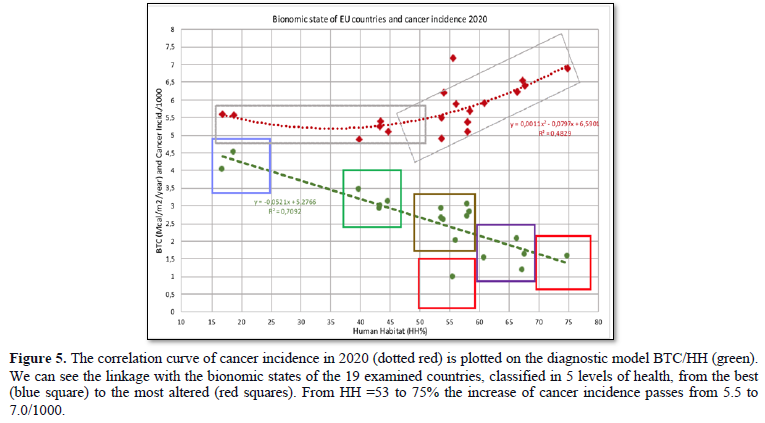
The correlations of the mentioned groups of ecological-bionomics parameters with Cancer Incidence have been studied and plotted to underlie their trend: Figure 6a presents the Forest cover correlation, becoming stronger in 2020, as the Organic farming, whose correlation in 2012 was lower. Deepening, the five Countries (Austria, Italy, Spain, Portugal, Romania) with minimum cancer incidence (mean 515.6/100,000) present an average 12,36% of Organic Farming as against the five Countries (Belgium, Nederland, Denmark, Ireland, and Hungary) with maximum cancer incidence (mean 666.8/100,000) with only 5.76% of Organic Farming!
Figure 6b shows evident correlations with GDP and HH, both in 2012 and 2020.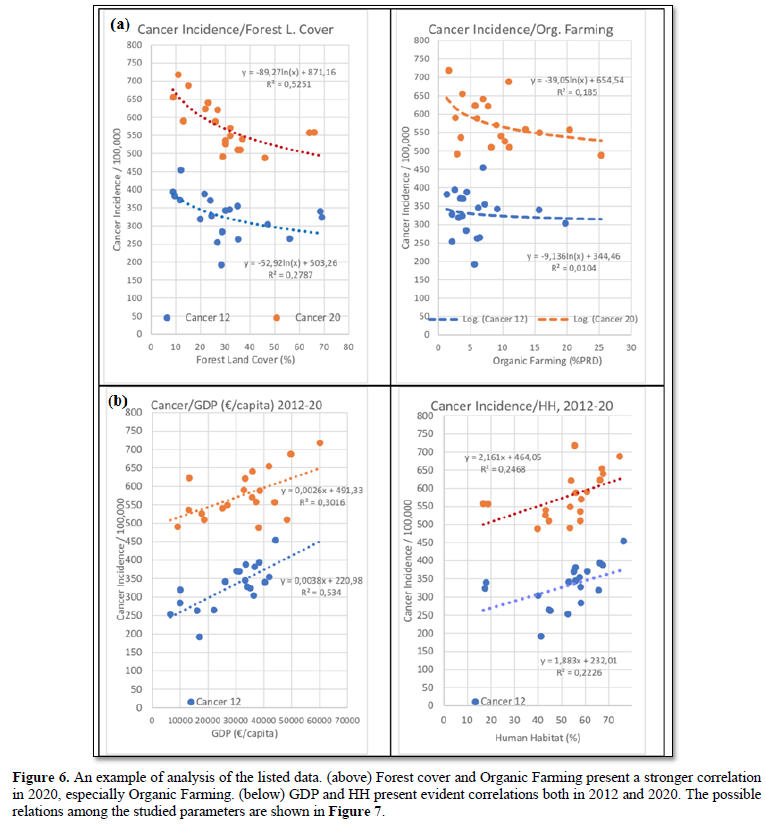
DEEPENING
In Figure 7(a), an evident correlation emerges between the % of Cancer Incidence and Forest cover Vs. the BTCw of the Countries, which results the most important parameter integrating vegetation’s metabolism, organization and information content, and linking the landscape health with human health. The relation Forest cover/countries’ BTCw indicates the altered state of agrarian landscapes because, if the mean BTCw of EU forests is 6.0-7.0 Mcal/m2/year (about 1/3 are truly protected), a country with BTCw=3.00 has a mean BTCw of agrarian landscapes equal to 0.90-1.0, too low (typical of industrial agriculture); in Figure 7(b), Organic Farming Vs. Forest Cover is also meaningful, because it confirms the dominance of industrial agriculture in plains which present Forest (Figure 6a).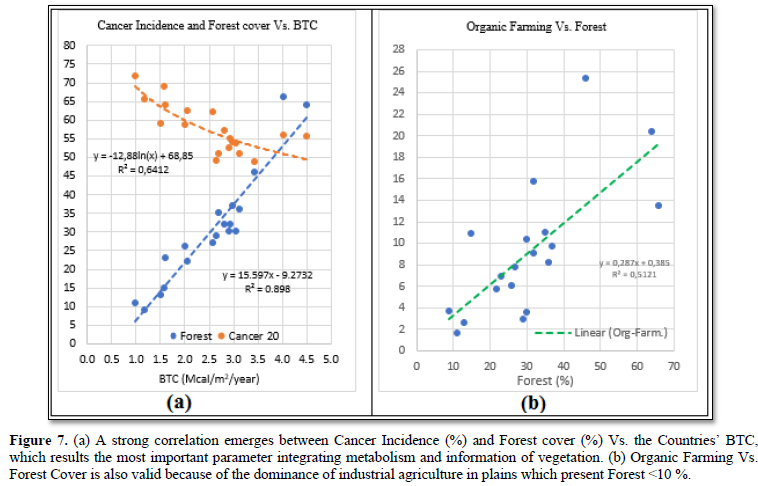
The Pearson coefficients of the analyzed correlations differs from 2012 to 2020, so even their correlation significance (Cr-Sg), the threshold of which is equal to 0.44 for a statistical population of 19 countries, as shown in Table 6 and Figure 8. It is stimulating to note that, after such a substantial cancer incidence increases, the significant correlations of ‘exceeding dysfunctional’ parameters lose importance compared to the ‘lack of protection’ ones: 6.30 Vs. 2.53 (2012) and 6.21 Vs. 4.14 (2020).
From Table 6 and Figure 8, we can see that the Cr-Sg of three parameters remain near-constant (HH, Urban-Population, Pesticides), two of them decrease (GDP/capita and Beef/capita), but four increase: Organic Farming (+ 4.14); Forest (+ 1.44); BTC (+ 1.37); Glyphosate (+ 1.23). So, an evident meaning depended on the alteration of agricultural landscapes emerges. In fact, the ratio of Cr-Sg Forest/countries’ BTCw passed from 76,2 % in 2012 to 80.5 % in 2020: if the forest cover acquires importance (+4.3% in 8 years) in the relation of BTC (the values of which depend on the two components of Forest and Cropland), this means a further degradation of agrarian landscapes; this alteration is also underlined by the increase of the Cr-Sg both of Organic Farming and Glyphosate. Note that the % increase 2012/20 of Organic Farming’s surface is equal to 1.5, so its Cr-Sg. increase, about 2.7 times wider, does not depend on the increase of its area but on its effect on cancer onset!
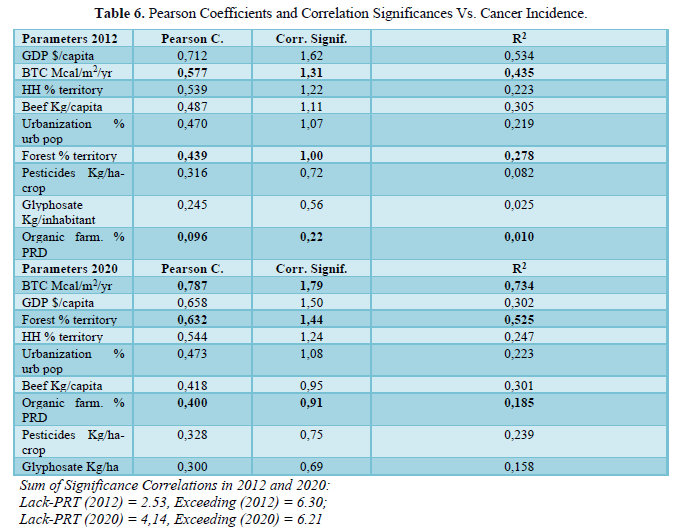
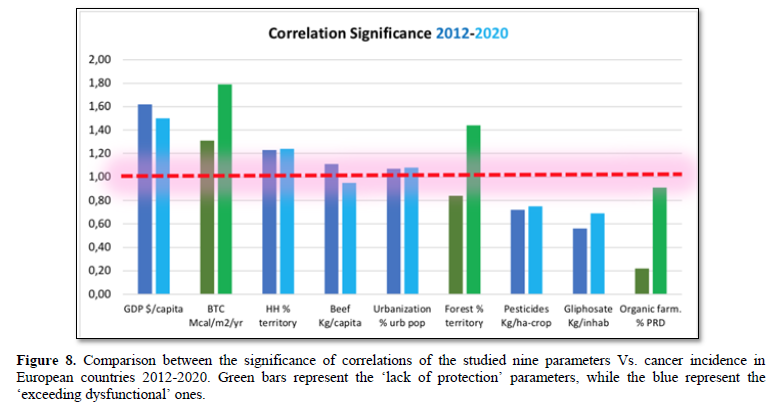
Moreover, in Table 6, we can see that, passing from 2012 to 2020, few parameters remain distant from the value of 1,00 (full significance).
DISCUSSION
We underlined (introduction) that biology's study must be upgraded even to the broader scales, particularly the landscape/regional one when dealing with human health. First results are evident, but how the alteration of life at the macro-scales can damage human health no less than at the micro-scales? The processes are numerous, for instance:
- the epigenetics links with the environment, through signal-molecules and transcription factors. E.g., Bottaccioli & Bottaccioli [8] remember that the methylation of onco-suppressor genes impedes the production of proteins with an anti-proliferative role in colon cancer or leukemia;
- the ethological alarm signals and their stress influence [23];
- the direct relation between psychic stress and inflammation [8,24];
- the influence of the environment on GM (Gut Microbiome), therefore on the brain [25];
- the ‘pruning effect’ for the environmental fitting of the brain [1];
- the influence and reconversions of zoonosis on human health [26];
- the scalar interactions among the hierarchical levels of biological organization [1];
- the interactions between the minimum vital space and the landscape apparatuses [1];
- the protective, balancing and buffer effects of the high BTC networks [1];
- the actions of forest phytoncides (e.g., essential oils) on the immune system [27];
- the environment’s control (EPB) on cultivation and production of food [28];
- the forest’s regulations of PM10 and CO2 and climate change [29].
Figure 9 presents a logical scheme, which tries to show the complexity of the interrelations between the environment and the insurgence or prevention of diseases (in this case ‘cancer’). A comparison between the flow path coming from altered environment (due to Bionomic dysfunction and lack of natural forests) bringing to ethological alarming signals and stressing influences, and the one generated by an optimal environment (due to Bionomic efficiency and remarkable presence of natural forests), generating relaxing signals and their recreational influences, occupy the central part of the diagram.
Following altered environment, the flow path links the Th2-Th17 immune circuit dysregulation to the ethological alarm signals and their stress influence and inflammation consequences (point ‘b-c’). Indeed, after millennia of co-evolution man-environment, a crucial ethological question emerges, linked to information, meaning, and survival, therefore to the concept of "values-judgment" [30]: this implies a correspondence between the perception of values and the passage from the most probable and disordered to the most ordered and improbable. This ethological process has an alarming meaning: it registers all the environmental alterations, which remain memorized within our cells. The ethological process has to be innate and unconscious because, to de-codify environmental signals, we must reduce emotions. This ethological information can be studied following the principles of psycho-neuro-endocrine-immunology [2] because a direct relation between psychic stress and inflammation is demonstrated [24]: the sympathetic nervous system and the hypothalamus-pituitary-adrenal axis mediate the integrated responses of the human organism to stress.
The main stressors simultaneously activate neurons in the hypothalamus, which secrete CRH (Corticotropin-releasing hormone) and adrenergic neurons [31]: these responses potentiate each other, at the central and the peripheral level. The final effect of the activation of neurons that secrete CRH is the increase in plasma levels of cortisol, while the net effect of adrenergic stimulation is to increase plasma levels of catecholamine: the negative feedback exerted by cortisol can limit an excessive reaction, which is dangerous for the organism. But, when the stress became chronic, the circadian rhythm of melatonin/cortisol is altered. Consequently, plasma levels of cortisol bring to a dominance of the Th2 immune circuit, which produces typical catecholamine (e.g., IL-4, IL-5, IL-13) and the circuit Th17 [2]. Remember, the Th2 immune response is not available to counteract viral infections, neo-plastic cells, auto-immune syndromes, which should need a Th1 response. We can deduce that most illness is linked with chronic stress conditions, confirming the intuitions of Selye [32]: a substantial increase in morbidity inevitably brings a rise in mortality rate (MR).
In the left part of Figure 9, focusing on the environmental alteration and the emergence of cancer, we find a violet frame containing four agents of modification:
- Stressing roads (traffic), low quality of labor and home environment [33].
- Industrial agriculture and poor feeding.
- No natural forests and poor phytoncides.
- Presence of pollution.
These agents present many linkages surrounding other agents and processes, interacting with, for instance, on the left,
- the Pruning effect sensu Gogtail [34], distorting brain-environment fitness;
- the lack of the correct constraints and feedbacks within the biological hierarchy (related to the destruction of agrarian landscapes), creating inadequate food and
- an altered gut-microbiome, leading to immune deregulation and increased inflammation, so to major diseases onset and cancer risk.
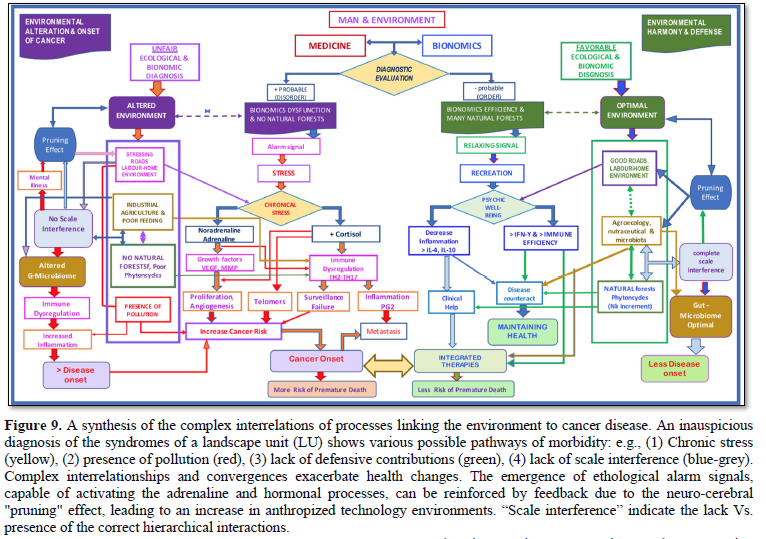
Conversely, the right part of this broad logic flow chart shows the interrelations in a semi specular manner. Thus, in center, Bionomic Efficiency and copious natural forests giving calming signals and so leading to psychic well-being, may develop favorable biochemical processes. For instance:
- decreasing inflammation enhancing IL-10, an immunomodulatory cytokine with a critical role in limiting inflammation in immune-mediated pathologies, or
- increasing IFN-γ, which activates macrophages and makes them better able to mount an effective immune response,
- enhancing antigen processing and presentation through upregulation of class II MHC, increased ROS and NOS production,
- inducing autophagy for clearance of intracellular pathogens etc.
Going on with the environmental rehabilitation and the prevention of cancer (right part), we find again a frame, green, containing three agents of healthy state:
- Bionomic-structured urbanized labor and home environment,
- Agroecology and well-feeding,
- Natural mature forests and copious phytoncides.
The healthy agents are three because of the absence of pollution. Agroecology is particularly essential: plant populations evolve under different agronomic management types and in response to specific combinations of landscape characters. In this way, the frequency of genotypes that have adapted to local conditions gradually increases [26]. Epigenetic processes lead this EPB (Evolutionary Plant Breeding); local environment characters guide DNA expressions and make them transmitted. These populations do not need to be treated with pesticides and herbicides. They are deeply linked with natural forest patches: Phytoncides (forest essential oils) have beneficial effects on natural killers (NK). In this positive case, the role of the neural Pruning Effect leads to developing man’s sensibility toward nature in the correct direction.
CONCLUSION
Medical communities are recognizing that human alteration of Earth’s ecological systems threatens the health of humanity. This fact has given rise to the field of Planetary Health [26,35], which is interdisciplinary but, first of all, it must be systemic: it needs a special relationship between Ecology and Medicine. This relation is to be upgraded because, today, ecology and medicine pursue few systemic characters and few correct interrelations.
In conclusion, we have to underline that environmental exposure and exchanges, and their interaction with the body’s biological systems and apparatuses, play an essential role in disease development. We started showing the importance of broad-scale biology, adding bionomic parameters to the carcinogenicity, as:
- the insufficient level of BTC, mainly due to agrarian landscape alterations,
- the weak HH/BTC ratio of many EU countries.
- the confirmation of danger due to glyphosate (kg/ha of PRD), and
- the strong increasing significance of Organic Farming, together with the increase of correlation significance of ‘lack of protective’ parameters Vs. ‘excess altering’ ones.
Therefore, we had to pass from qualitative to quantitative considerations, related to macro-scale biology's influence on human health in the scientific way, suggested by landscape bionomics principles and methods. This fact underlines a more efficient control of environmental rehabilitation to enhance prevention against cancer and to indicate therapeutic integration fields between chemical and biological cares.
On the other side, the possibility to evaluate the bionomic state of the landscape units and consequently to correlate its bionomic functionality (BF) with the mortality rate [23] reinforces the possibility to control the environmental syndromes and reduce the impacts of transformation and to advise the local Authorities for the necessity to ecological rehabilitation.
[1]LANDSCAPES: from 102 to 104 km2; REGIONS: from 104 km2 to 106 km2
[2]All in contrast with the definition of landscape given by the EU Landscape Convention, mainly perceptive, where the landscape does not reach an intrinsic biological value!
[3]A state function is a property whose value does not depend on the path taken to reach that specific value. In contrast, functions that depend on the path between two values are call path functions. Both path and state functions are often encountered in thermodynamics
-
Ingegnoli V (2015) Landscape Bionomics. Biological-Integrated Landscape Ecology. Springer, Heidelberg, Milan, New York. pp: XXIV + 431.
-
Crick F (1970) Central Dogma of Molecular Biology. Nature 227: 561-563.
-
Waddington CH (1961) The nature of life. Atheneum, New York.
-
Bertolaso M (2018) Biological Robustness - Emerging Perspectives from within the Life Sciences, in History, Philosophy and Theory of the Life Sciences, vol. 23. Springer.
-
Agazzi E (2004) Right, Wrong and Science. The Ethical Dimension of the Techno-Scientific Enterprise, Amsterdam-New York, Rodopi.
-
Urbani-Ulivi L (2019) The Systemic Turn in Human and Natural Sciences. A Rock in the Pond. Springer-Nature, Switzerland.
-
Ingegnoli, V. (2019) Is Present Ecology a Systemic Discipline? New Scientific Paradigms Lead to Bionomics. In: Urbani-Ulivi L ed. (2019) The Systemic Turn in Human and Natural Sciences. Pp: 61-82. Springer-Nature, Switzerland.
-
Bottaccioli F, Bottaccioli AG (2020) Psycho-Neuro-Endocrine-Immunology and Science of Integrated Care. Edra Ed. Milano.
-
Ingegnoli V (2011) Landscape Bionomy. The biological-integrated landscape ecology for the training of a "doctor" of ecological systems. Springer-Verlag, Milan. Foreward by Giacomo Elias, pp: XX+340.
-
Ingegnoli V, Bocchi S, Giglio E (2017) Landscape Bionomics: A Systemic Approach to Understand and Govern Territorial Development. WSEAS Trans Environ Dev 13: 189-195.
-
Odum EP (1971) Fundamentals of Ecology. Saunders, Philadelphia, USA.
-
Lovelock J, Margulis L (1974) Atmospheric Homeostasis by and for the Biosphere: The Gaia Hypothesis. Tellus XXVI.
-
Ingegnoli V (2001) Landscape Ecology. In: Baltimore D., Dulbecco R., Jacob F., Levi- Montalcini R. (Eds.) Frontiers of Life. New York, Boston, Academic Press Vol IV, pp 489-508.
-
Ingegnoli V (2002) Landscape Ecology: A Widening Foundation. Berlin, New York, Springer, pp: XXIII+357.
-
Ingegnoli, V. & Giglio, E. (2005). Ecologia del Paesaggio: manuale per conservare, gestire e pianificare l’ambiente. Sistemi Editoriali SE, Napoli, pp. 685+XVI.
-
Ingegnoli V, Pignatti S (2007) The impact of the widened Landscape Ecology on Vegetation Science: Towards the new paradigm. Springer, Rendiconti Lincei Scienze Fisiche e Naturali, s. IX, XVIII: 89-122.
-
European Environmental Agency (2007) European forest types, categories and types for sustainable forest management reporting and policy. Technical report No 9/2006, Copenhagen. Available online at: https://www.foresteurope.org/docs/other_meetings/2006/wfc/WFC_4_eea_technical_report_92006.pdf
-
European Environmental Agency (2017) Country fact sheet, Land cover 2012. Copenhagen.
-
European Environmental Agency (2020) Land Use, Land cover country fact sheets. Copenhagen.
-
FAO (2020) The state of the world’s Forests 2020. Rome. Available online at: http://www.fao.org/3/ca8642en/CA8642EN.pdf
-
Steliarova-Foucher E, O’Callaghan M, Ferlay J, Masuyer E, Rosso S, et al. (2014) The European Cancer Observatory: A new data resource. Eur J Can 51: 1131-1143.
-
European Cancer Information System (2020) Incidence and mortality estimates 2020. European Commission, Brussel.
-
Ingegnoli V, Giglio E (2017) Complex environmental alterations damages human body defense system: A new bio-systemic way of investigation. WSEAS Trans Environ Dev, pp: 170-180.
-
Slavich GM, Thornton T, Torres LD, Monroe SM, Gotlib IH (2009) Targeted rejection predicts hastened onset of major depression. J Soc Clin Psychol 28(2): 223-243.
-
Thursby E (2017) Introduction to the human gut microbiota. Biochem J 474(11): 1823-1836.
-
Myers S, Frumkin O (2020) Planetary Health: Protecting Nature to Protect Ourselves. Island Press, USA.
-
Li Q (2009) Effect of forest bathing trips on human immune function. Environ Health Prev Med 15(1): 9-17.
-
Ceccarelli S (2013) Produrre i propri semi. Manuale per accrescere la biodiversità e l’autonomia nella coltivazione delle piante alimentari. Libreria Editrice Fiorentina, Firenze.
-
Barò F, Chaparro L, Gómez-Baggethun E, Langemeyer J, Nowak DJ, et al. (2014) Contribution of Ecosystem Services to Air Quality and Climate Change Mitigation Policies: The Case of Urban Forests in Barcelona, Spain. Ambio 43(4): 466-479.
-
Lorenz K (1978) Comparative Behavioral Research: Basics of Ethology. Berlin, Wien, Springer-Verlag.
-
Berne RM, Levy MN (1990) Principles of Physiology. The CV Mosby Company, USA.
-
Selye H (1956) The stress of life. McGrow-Hill, NY.
-
WHO (2018) Preventing disease through healthy environments: A global assessment of the burden of disease from environmental risks? Available online at: https://www.who.int/publications/i/item/9789241565196
-
Gogtay N, Giedd JN, Lusk L, Hayashi KM, Greenstein D, et al. (2009) Dynamic mapping of human cortical development during childhood through early adulthood. Proc Natl Acad Sci U S A 101(21): 8174-8179.
-
Almada AA, Golden CD, Osofski SA, Myers SS (2017) A case for Planetary Health/Geo Health. Geohealth 1: 75-78.
QUICK LINKS
- SUBMIT MANUSCRIPT
- RECOMMEND THE JOURNAL
-
SUBSCRIBE FOR ALERTS
RELATED JOURNALS
- Journal of Blood Transfusions and Diseases (ISSN:2641-4023)
- Journal of Infectious Diseases and Research (ISSN: 2688-6537)
- BioMed Research Journal (ISSN:2578-8892)
- International Journal of Radiography Imaging & Radiation Therapy (ISSN:2642-0392)
- International Journal of Medical and Clinical Imaging (ISSN:2573-1084)
- Advance Research on Endocrinology and Metabolism (ISSN: 2689-8209)
- Advance Research on Alzheimers and Parkinsons Disease












